
Dagali is a small mountain village in Buskerud, Norway.

Dagali is a small mountain village in Buskerud, Norway.
Dagali is located in Hol municipality. The village stretches from Pålsbufjorden on the east to the border of the Hardangervidda National Park in the west, a distance of approximately 40 km. The river Numedalslågen runs through the village. Dagali had an airport, Geilo Airport, Dagali, that is no longer in use. The site is currently used by Dagali Opplevelser, which offers outdoor recreational activities including water rafting and snowmobiling. [1] [2]
Dagali Church (Dagali kirke) dates from 1850. The church was constructed of wood and has the seating capacity of around 200 people. Dagali church was rebuilt and restored during 1972–73. Dagali Church is located off Norwegian National Road Rv 40, about 25 kilometres from Geilo. [3]
Climate
Dagali features a subarctic climate (Köppen Dfc) with cold, extremely snowy winters and somewhat cool summers, typical of higher altitudes (798m asl). Dagali airport weather station has some of the coldest temperatures in Southern Norway with a mean temperature in the coldest month (January) of -11,2 °C for the period 2001 to present. This is especially true considering how much the climate of Norway has warmed only in the last decades. Precipitation remains moderate at 515mm yearly (Fagerlund 871m asl - 1958-88) for one of the two weather stations there (one no longer in usage). [4]
| Climate data for Dagali-Airport (2001-present) for temperatures and Dagali-Fagerlund for precipitation (1958-88), Norway | |||||||||||||
|---|---|---|---|---|---|---|---|---|---|---|---|---|---|
| Month | Jan | Feb | Mar | Apr | May | Jun | Jul | Aug | Sep | Oct | Nov | Dec | Year |
| Daily mean °C (°F) | −11.2 (11.8) | −9.5 (14.9) | −6.0 (21.2) | −1.5 (29.3) | 4.4 (39.9) | 9.4 (48.9) | 11.0 (51.8) | 9.7 (49.5) | 5.1 (41.2) | 0.8 (33.4) | −4.5 (23.9) | −7.7 (18.1) | 0.0 (32.0) |
| Average precipitation mm (inches) | 33 (1.3) | 23 (0.9) | 27 (1.1) | 23 (0.9) | 37 (1.5) | 54 (2.1) | 69 (2.7) | 65 (2.6) | 51 (2.0) | 53 (2.1) | 42 (1.7) | 38 (1.5) | 515 (20.4) |
| Source: [4] | |||||||||||||
Averages from the no longer operational Dagali-Fagerlund and extremes. Back then, January averaged -8.9 and July averaged 10.8 making it still a subarctic (Dfc) climate.
| Climate data for Dagali-Fagerlund 1961-1990, extremes 1885-2015 | |||||||||||||
|---|---|---|---|---|---|---|---|---|---|---|---|---|---|
| Month | Jan | Feb | Mar | Apr | May | Jun | Jul | Aug | Sep | Oct | Nov | Dec | Year |
| Record high °C (°F) | 7.5 (45.5) | 7.4 (45.3) | 8.5 (47.3) | 13.6 (56.5) | 21.0 (69.8) | 26.3 (79.3) | 27.5 (81.5) | 28.0 (82.4) | 23.0 (73.4) | 20.8 (69.4) | 10.0 (50.0) | 7.2 (45.0) | 28.0 (82.4) |
| Mean daily maximum °C (°F) | −5.2 (22.6) | −3.7 (25.3) | −1.0 (30.2) | 3.0 (37.4) | 9.2 (48.6) | 14.5 (58.1) | 15.7 (60.3) | 14.8 (58.6) | 10.2 (50.4) | 5.6 (42.1) | −0.7 (30.7) | −3.6 (25.5) | 4.9 (40.8) |
| Mean daily minimum °C (°F) | −12.6 (9.3) | −12.3 (9.9) | −9.8 (14.4) | −5.6 (21.9) | 0.2 (32.4) | 4.5 (40.1) | 6.0 (42.8) | 5.4 (41.7) | 2.4 (36.3) | −0.9 (30.4) | −7.3 (18.9) | −10.7 (12.7) | −3.4 (25.9) |
| Record low °C (°F) | −39.0 (−38.2) | −30.3 (−22.5) | −28.6 (−19.5) | −21.0 (−5.8) | −13.6 (7.5) | −5.2 (22.6) | −1.0 (30.2) | −4.1 (24.6) | −7.9 (17.8) | −17.3 (0.9) | −25.9 (−14.6) | −34.0 (−29.2) | −39.0 (−38.2) |
| Average precipitation mm (inches) | 33 (1.3) | 23 (0.9) | 27 (1.1) | 23 (0.9) | 37 (1.5) | 54 (2.1) | 69 (2.7) | 65 (2.6) | 51 (2.0) | 53 (2.1) | 42 (1.7) | 38 (1.5) | 515 (20.4) |
| Average precipitation days | 8.9 | 5.8 | 7.2 | 6.0 | 7.3 | 9.4 | 11.2 | 10.4 | 9.3 | 9.7 | 9.5 | 9.2 | 103.9 |
| Source: Met Norway Eklima | |||||||||||||
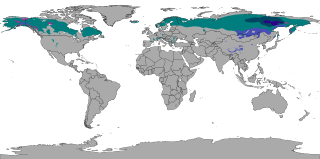
The subarctic climate is a continental climate with long, cold winters, and short, warm to cool summers. It is found on large landmasses, often away from the moderating effects of an ocean, generally at latitudes from 50°N to 70°N, poleward of the humid continental climates. Subarctic or boreal climates are the source regions for the cold air that affects temperate latitudes to the south in winter. These climates represent Köppen climate classification Dfc, Dwc, Dsc, Dfd, Dwd and Dsd.

Hol is a municipality in Buskerud county, Norway.

Sigdal is a municipality in Buskerud county, Norway. The administrative centre of the municipality is the village of Prestfoss.

Continental climates often have a significant annual variation in temperature. They tend to occur in the middle latitudes, within large landmasses where prevailing winds blow overland bringing some precipitation, and temperatures are not moderated by oceans. Continental climates occur mostly in the Northern Hemisphere due to the large landmasses found there. Most of northern and northeastern China, eastern and southeastern Europe, much of Russia south of the arctic circle, central and southeastern Canada, and the central and northeastern United States have this type of climate. Continentality is a measure of the degree to which a region experiences this type of climate.

Kittilä is a municipality of Finland and a popular holiday resort.

The Köppen climate classification is one of the most widely used climate classification systems. It was first published by German-Russian climatologist Wladimir Köppen (1846–1940) in 1884, with several later modifications by Köppen, notably in 1918 and 1936. Later, German climatologist Rudolf Geiger (1894–1981) introduced some changes to the classification system in 1954 and 1961, which is thus sometimes called the Köppen–Geiger climate classification.

Numedal is a valley and a traditional district in Eastern Norway located within the county of Buskerud. It traditionally includes the municipalities Flesberg, Nore og Uvdal and Rollag. Administratively, it now also includes Kongsberg.

Embarrass is an unincorporated community in Embarrass Township, Saint Louis County, Minnesota, United States.
Geilo is a centre in the municipality of Hol in Viken county, Norway. Geilo is primarily a ski resort town, with around 2,500 inhabitants. It is situated in the valley of Hallingdal, 250 km from Oslo and 260 km from Bergen. The Bergen Line facilitated Geilo's development as the first skiing resort in the country, and it is still one of the largest. It is also known for having some of the most luxurious and expensive holiday cabins in Norway. The center of the town lies at 800 meters above sea level, and its highest point is 1178 meters above sea level.

Eyrarbakki is a fishing village on the south coast of Iceland with a population of about 570 people, not including inhabitants of the prison located there. The village is founded on the Great Þjórsá Lava.

Dagali Museum is a small local museum in Dagali, within the Hol municipality in Viken county, Norway. The museum is a subsidiary of the Hallingdal Museum.

Kvilda is a municipality and village in Prachatice District in the South Bohemian Region of the Czech Republic. It has about 100 inhabitants. At an altitude of 1,065 metres (3,494 ft), it is the highest municipality in the Czech Republic. It is also one of the coldest places in the country.
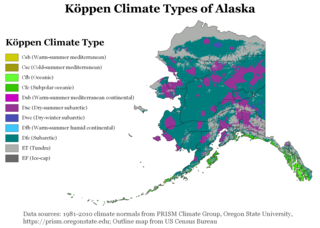
The climate of Alaska is determined by average temperatures and precipitation received statewide over many years. The extratropical storm track runs along the Aleutian Island chain, across the Alaska Peninsula, and along the coastal area of the Gulf of Alaska which exposes these parts of the state to a large majority of the storms crossing the North Pacific. The climate in Juneau and the southeast panhandle is a mid-latitude oceanic climate, in the southern sections and a subarctic oceanic climate in the northern parts. The climate in Southcentral Alaska is a subarctic climate due to its short, cool summers. The climate of the interior of Alaska is best described as extreme and is the best example of a true subarctic climate, as the highest and lowest recorded temperatures in Alaska have both occurred in the interior. The climate in the extreme north of Alaska is an Arctic climate with long, cold winters, and cool summers where snow is possible year-round.

Mohe is a county-level city in Daxing'anling Prefecture, Heilongjiang province. It is the northernmost city in China.
Panjab is the capital of Panjab District, a mountainous district in the southwestern part of the Bamyan Province, Afghanistan. The town is situated at 34°23'N 67°1'E and has an altitude of 2,758 m altitude, the population was 9,900 in the year 2004. There is an airport with gravel surface.
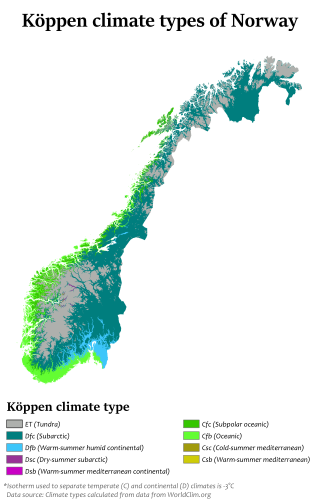
The climate of Norway is more temperate than could be expected for such high latitudes. This is mainly due to the North Atlantic Current with its extension, the Norwegian Current, raising the air temperature; the prevailing southwesterlies bringing mild air onshore; and the general southwest–northeast orientation of the coast, which allows the westerlies to penetrate into the Arctic. The January average in Brønnøysund is 15.8C (28.6F) higher than the January average in Nome, Alaska, even though both towns are situated on the west coast of the continents at 65°N. In July the difference is reduced to 3.2C (5.8F). The January average of Yakutsk, in Siberia but slightly further south, is 42.3C (76.1F) lower than in Brønnøysund.
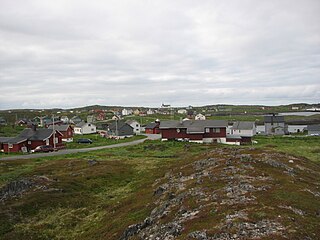
Gamvik is a fishing village in Gamvik Municipality in Troms og Finnmark county, Norway. The village is located on the northern shore of the Nordkinn Peninsula, along the Barents Sea. The village is the second largest settlement in Gamvik municipality, after the municipal centre of Mehamn which is located about 16 kilometres (9.9 mi) to the west. Gamvik is home to the Gamvik Museum and Gamvik Church. The village is an old church site with churches located here since at least the 1850s.

Bor is a rural locality in Turukhansky District of Krasnoyarsk Krai, Russia, located on the Yenisei River just downstream of its confluence with the Podkamennaya Tunguska.
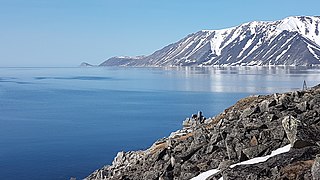
Beringia National Park is on the eastern tip of Chukotka Autonomous Okrug ("Chukotka"), the most northeastern region of Russia. It is on the western side of the Bering Strait.
Nattavaara is a minor locality in Gällivare Municipality, Norrbotten County in the province of Lapland in Sweden. The settlement had a permanent population of 114 as of the year 2015. Nattavaara is located 53 kilometres (33 mi) by road south of municipal seat Gällivare. That is also the nearest urban area, with Jokkmokk being slightly further away to the southwest. The only paved roads are to the north and the east, whereas the Jokkmokk road transitions into a gravel road just west of the village.
60°24′42″N8°26′35″E / 60.41167°N 8.44306°E